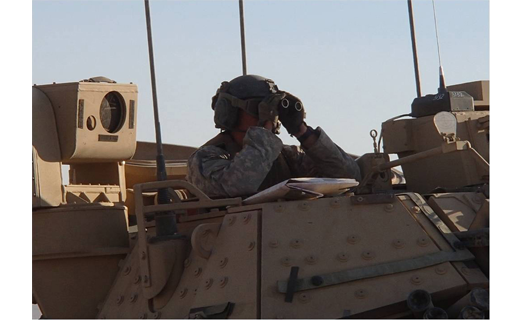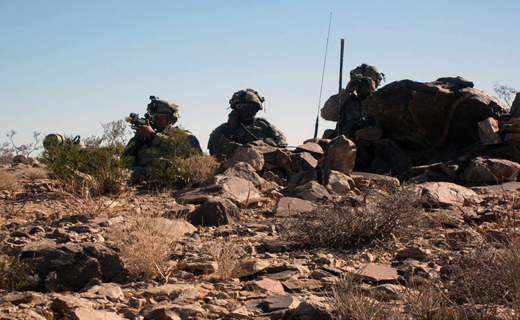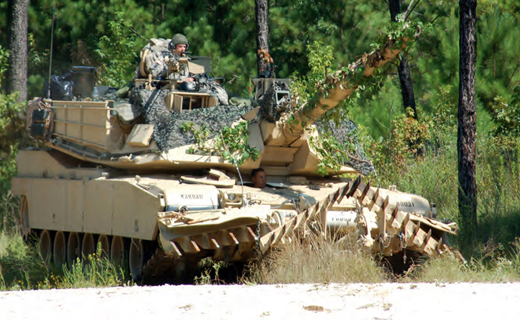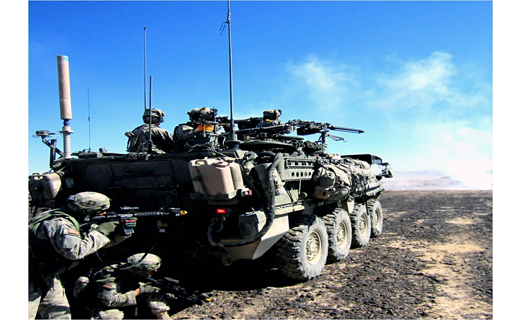Project Warrior: Bridging the Gap between the Operational and Institutional Domains




“You haven’t heard? Project Warrior is back!”
Because high operational tempo and officer timelines were not able to support this great initiative over the last decade of war, theProject Warrior Program was jumpstarted by GEN Raymond T. Odierno, the Army’s Chief of Staff, in Spring 2013. At its foundation, the program is intended “to infuse observations and experiences gained from multiple, immersive combat training center (CTC) rotations back into the Army through select professional military education (PME) courses.”1
Our Army rightly recognizes that through combat deployments to Iraq and Afghanistan, our core of company and field-grade officers has built a wealth of knowledge and experience during counterinsurgency operations abroad. However, while unit training and leader development evolves as we focus on the range of military operations associated with “unified land operations through decisive action,”2 there is extreme value in placing hand-selected, successful, post-command company-grade officers at our CTCs to serve as observers/controllers/trainers (O/C/Ts) for upward of 18 months and then placing them in the various Army centers of excellence (CoEs) as small-group leaders/instructors (SGLs). This initiative fuses these officers’ operational experiences with CTC institutional experiences so they can profitably coach, teach and mentor other junior company-grade officers, not only at the CTCs but also, perhaps more importantly, at our various CoEs’ captain’s career courses.
From the field to the classroom – what are we seeing?
The comprehensive list of lessons-learned – both at the CTCs and in the Maneuver Captain’s Career Course (MCCC) classrooms – could fill volumes, and as the Project Warrior Program matures, there will likely be a continuous flow of recommendations and best practices pushed back out to the operational forces. As learning organizations, the relationship between the CTCs’ task forces and MCCC faculty continues to grow stronger so we can collectively have a shared vision of the challenges maneuver captains are having at the CTCs – and so we at Fort Benning can address those issues in our classroom instruction and practical application. Our Project Warrior SGLs at MCCC have been the connective tissue who have facilitated this blossoming relationship between the organizations.
That being said, this article is structured to provide the reader our observations on the most significant company-level challenges observed across multiple rotations and in the classroom, involving all types of brigade combat teams (BCTs) executing a variety of missions. A number of key observations and lessons-learned are centered on leaders’ ability to effectively execute each step of the troop-leading procedures (TLPs).3 Many of these trends have residual effects and carry over to the battalion and brigade levels. By identifying and overcoming these challenges at company level, there will likely be positive second- and third-order effects at higher echelons as well.
Following are major trends observed on company-level TLPs:
- Step 1: Receive the mission. Company-level leaders often wait for a complete, written operations order (OPORD) from their battalion before they begin planning. Instead, when possible, leaders should initiate their planning effort before receiving the higher headquarters’ OPORD. An extremely common error that continues to exist is that leaders inadvertently set themselves up for failure by immediately getting behind on the 1/3 - 2/3 rule during the first step of TLPs, further contributing to their subordinates not having time to plan and, at times, leading to mission failure – or, at minimum, friction during execution. Leaders simply do not determine their time allocations for planning, preparation or execution within the TLP process.
At MCCC, we have instituted in all planning blocks – and encourage other company-grade-officer PME courses to do the same – the issuing of a series of battalion warning orders (WARNOs) during the company-level practical application OPORD process. This forces students to correct this deficiency and thereby reinforces parallel planning as early as possible throughout the operations process. Units in the operational Army must reinforce and emphasize parallel planning, issuing WARNOs as more information becomes available during the planning process to reinforce this practice. - Step 2: Issue a WARNO. To compound the issue with Step 1, company commanders routinely fail to issue timely WARNOs to facilitate subordinate parallel planning and preparation efforts. While trying to craft a near-perfect OPORD, commanders fail to relate information from their initial course-of-action (CoA) development into their subsequent WARNOs.
MCCC currently requires students to issue complete initial WARNOs but does not require them to issue subsequent WARNOs. The SGLs coach the students to issue a second WARNO, but it is not required at this time, and we find that it is an informal measure of effectiveness to see where and when in the program of instruction students start to “get it.” - Step 3: Make a tentative plan. When making a tentative plan, company-level leaders often conduct CoA development sufficiently but fail to conduct CoA analysis (wargaming) before selecting a CoA. As a result, the commander hinders his ability to make accurate decisions, identify friction points and mitigate risks, then synchronize a fully developed plan in time and space. Many of the holes or gaps in commanders’ plans can be identified and mitigated before execution if only they took the precious time to wargame their plan. A wargame will give company commanders the tools (decision-support matrix/template, synchronization matrix, execution checklist, etc.) they need to accurately synchronize the warfighting functions to accomplish the mission. Without going through the mental process of considering their unit’s action, the enemy’s counteraction and their reaction to the enemy, company commanders fail to plan for contingencies, develop branch or sequel plans and develop the tools needed to synchronize the entire operation.
MCCC SGLs are increasing their efforts to teach and coach maneuver captains through wargaming, as institutionally the Army has been challenged in this area for more than a decade in our planning processes at the company level and above. Also, students in the battalion phases are getting a healthy dose of wargaming to standard in an effort to better prepare them as future staff officers. This is currently an unfortunate shortcoming of many battalion-level staffs. To aid the overall improvement of CoA analysis as an Army, staffs must demonstrate the value of the wargames by conducting them to standard and thus setting the example for company commanders. - Step 4: Initiate movement. Commanders understand the need to initiate necessary movement prior to the execution of their mission but often lack the trust or confidence in their subordinates to execute the movement without direct oversight. One recent example from the National Training Center (NTC) highlights a mission in which a commander postponed his reconnaissance of a defensive engagement area to oversee the movement of his company into an assembly area.4 Failing to sufficiently account for movement during the conduct of TLPs can completely desynchronize a unit’s timeline. It is imperative that both institutional and operational training place a focus on fostering a certain degree of trust in and delegating responsibility to subordinate leaders.
- Step 5: Conduct reconnaissance. Currently, companies are severely unpracticed in planning and conducting reconnaissance in support of their operations. All tactical leaders, not just those in Cavalry organizations, have to understand reconnaissance and information-collection (IC) planning. A common trend, if not epidemic, is that maneuver commanders at all levels rarely develop IC plans in enough detail and fail to issue commander’s reconnaissance guidance, which informs their maneuver plan. Reconnaissance elements and organic unmanned aerial surveillance (UAS) platforms are not effectively used to answer priority intelligence requirements or to overwatch named areas of interest (NAI) or targeted areas of interest. The root cause behind this is that commanders rarely visualize nor understand how their portion of IC ties into the higher unit’s IC plan and their own ground-maneuver plan. Companies need to fight for information to increase their chances for operational success by conducting leaders’ reconnaissance, using organic UAS assets and deliberately planning reconnaissance in support of their operations.
Over the last year, MCCC has made major strides to overcome this institutional gap in temporal understanding of IC planning and execution, and how it’s directly tied to successful mission execution. During both company- and battalion-level practical application at MCCC, students are required to develop tactically executable IC plans that their SGLs thoroughly review and critique in an effort to coach students to become more proficient in this institutional deficiency.
While it would be developmental for all officers, leaders of specialized reconnaissance units (scout platoons/Cavalry troops) should, without exception, be afforded the opportunity to attend specialized courses such as the Army Reconnaissance Course, Reconnaissance and Surveillance Leader’s Course (RSLC) and Cavalry Leader’s Course (CLC) to further their understanding of IC planning and operations. Doing so would increase the effectiveness of those units but would also aid in reversing the widespread lack of understanding of IC.
- Step 6: Complete the plan. A reoccurring CTC observation is that companies often do not incorporate the requisite amount of tactical graphic or direct fire-control measures to control maneuver and fire. During a recent teleconference with O/C/Ts from Joint Readiness Training Center (JRTC), we learned that an estimated 33 percent of company commanders were assessed to use graphic control measures “sufficiently.”5 One reason contributing to this issue is that battalion OPORDs often do not include enough operational graphics and/or only provide intent graphics. Leaders later in the execution phase see their failure to use graphics properly when their scheme of maneuver becomes completely desynchronized and/or when fratricide occurs.
Most students report to MCCC untrained or unpracticed – though they just came from the operational forces – in the use of control measures. Therefore, MCCC SGLs spend a great amount of time emphasizing the proper use of maneuver graphics and direct fire-control measures in all modules of instruction throughout the course. SGLs ensure students strike the right balance between a lack of control measures and too many, then ensure they are using the right type of control measure within their plan’s construct. The doer does what the checker checks, so increased emphasis in the operational forces through backbriefs and leader checks on subordinate graphics will help all tactical leaders to properly apply the science of control to their operations successfully. - Step 7: Issue the order. The CTCs routinely state that the MCCC OPORD format and course standards are an effective model to build future company commanders who can provide logical, succinct and complete orders to subordinates. At MCCC, we found that the operational Army through a decade of war has developed a “concept of operations (CONOP) generation” of officers. Officers have turned this originally intended briefing tool into a lazy man’s way to plug and play tactical operations, leading officers to simply fill in the blanks on a preformatted PowerPoint slide that has no depth of thought and fails in execution. The O/C/Ts at JRTC have recently reported that about 66 percent of company commanders use the standard OPORD format they were taught during MCCC, while 33 percent revert to a CONOP format.6 CTC observations have concluded that mapboards and other analog OPORD products work well, but digital OPORD templates often lead to a more incomplete brief because digital formats tend to be based on CONOP templates. To fix this issue, the operational force should increase emphasis on ensuring that company-level leaders brief complete OPORDs, which facilitate a deep and shared understanding of the plan.
- Step 8: Supervise and refine. The CTCs often report that company-level leaders do not perform effective and thorough rehearsals before mission execution. Rehearsal guidance is supposed to be issued in the initial WARNO and then executed to enforce tactical situational awareness prior to execution by all Soldiers in the formation – while ensuring all assets and enablers synchronized in the plan. Synchronization tools such as execution matrices, decision-support matrices, IC matrices and operational graphics developed through wargaming are used during these rehearsals.
MCCC currently provides instruction on the conduct of rehearsals, and students execute seminar-level rehearsals in each module of the company and most battalion phases. We also use virtual and gaming simulations to conduct execution of students’ plans to reinforce the importance of proper wargaming and rehearsals. The operational forces’ battalion-level leaders need to continue this effort, conducting realistic rehearsals by forcing company leaders to have solid standard operating procedures for rehearsals so they become well practiced in their conduct.
Road ahead
The Project Warrior Program has been instrumental in MCCC connecting with the CTCs – who are conducting evaluated tactical operations in a field environment – to purposefully refine our classroom instruction to produce a better maneuver captain upon graduation. Currently MCCC has two Project Warrior SGLs, but over the next year, we are projected to increase that number up to seven. No doubt their wealth of experience from not only their time as a successful company commander but as an O/C/T will contribute to our effort to teach and prepare our MCCC students to be well prepared for the challenges ahead as they lead Soldiers in a complex world.
For this project to be successful well into the future, brigade and battalion commanders throughout the operational force must identify and recommend their strongest-performing officers for this program to their Human Resource Command branch manager. Per Military Personnel Message 13-137, officers can be identified as early as senior lieutenants and must undergo several screenings through their progression to SGL. These officers not only require a high level of institutional knowledge but also a natural ability to develop other leaders. With the right officers, the Project Warrior Program will continue to serve as a conduit to incorporate observations and lessons-learned from the Army’s operational force to its institutional instruction well into the future.
Notes
1 Military Personnel Message No. 13-137, “Project Warrior Program Eligibility Criteria and Selection Process,” issued June 3, 2013.
2 Army Doctrine Publication 3-0, Unified Land Operations, May 2012.
3 Field Manual 6-0, Commander and Staff Officer Organization and Operations, Chapter 10, May 2014.
4 Monthly CTC and MCCC lessons-learned conference call, June 13, 2014.
5 Monthly CTC and MCCC lessons-learned conference call, dated Aug. 24, 2014.
6 Ibid.
 email
email print
print